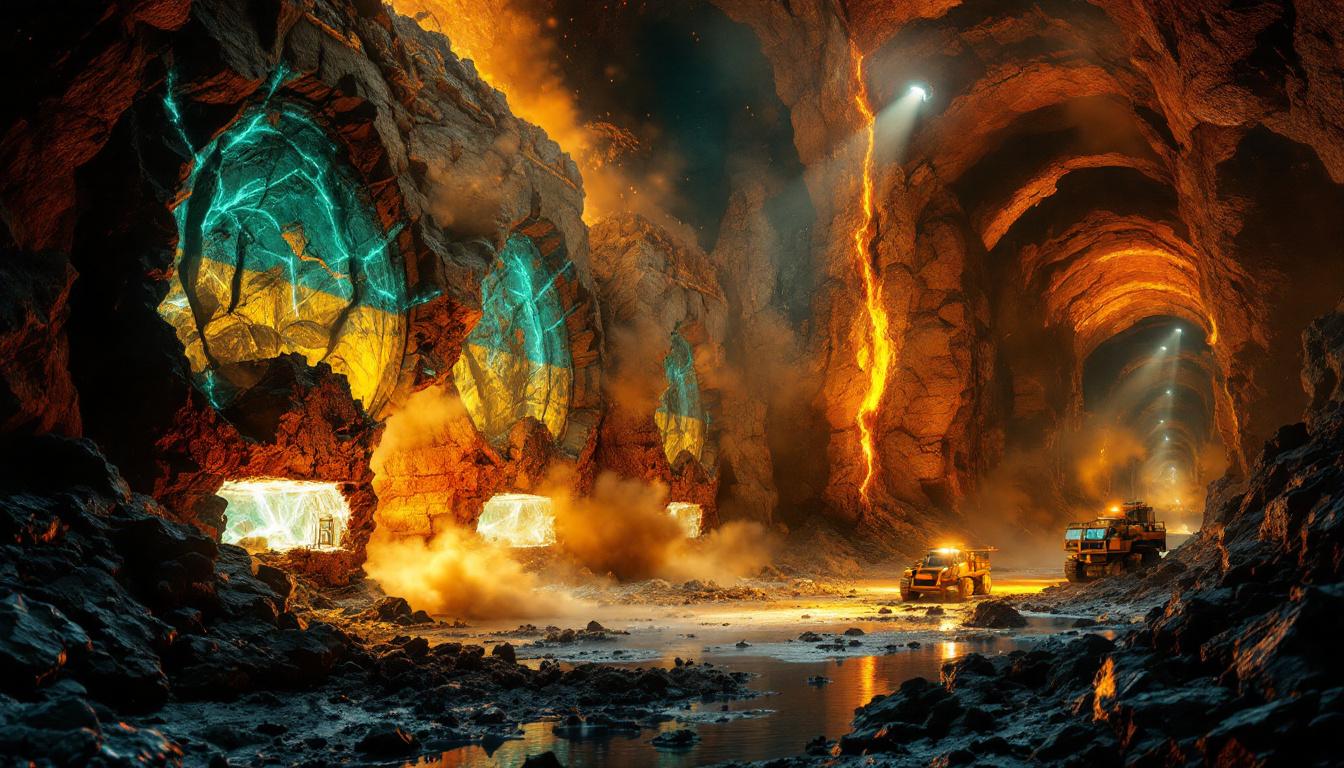Military-Grade Antimony Production: The Strategic Race for Domestic Supply
The United States faces a critical turning point in its approach to antimony, a mineral that has quietly become one of the most strategically important resources for military applications. As global supply chains face unprecedented pressure and prices reach record levels, the race to develop domestic antimony production has taken on new urgency – particularly for high-purity, military-grade antimony and production by year-end essential to national defense.
Recent developments at Alaska's Treasure Creek Project highlight a potential breakthrough in domestic antimony production, with metallurgical testing achieving exceptional results: concentrate grades up to 69% antimony with recovery rates exceeding 85%. These technical achievements place this emerging project in a unique position to potentially deliver military-grade antimony and production by year-end 2025.
What Makes Antimony a Critical Military Mineral?
The Strategic Importance of Antimony in Defense Applications
Antimony's critical role in military applications extends far beyond common knowledge. This metalloid serves as an irreplaceable component in numerous defense technologies that directly impact battlefield effectiveness and soldier safety.
In ammunition manufacturing, antimony hardens lead, significantly increasing penetration capabilities while improving ballistic performance. According to NATO STANAG 4107 standards, antimony content directly correlates with armor-piercing effectiveness in various calibers of military ammunition.
Perhaps most crucially, antimony trioxide serves as the primary flame retardant in military textiles, vehicles, and aircraft. These compounds provide essential protection by:
- Reducing flame spread rates by up to 70% in military-grade textiles
- Increasing escape time by 300% during fire incidents in military vehicles
- Meeting stringent MIL-STD-2031 requirements for flame suppression in enclosed spaces
The U.S. Department of Defense has emphasized in its 2024 Annual Industrial Capabilities Report that "antimony's role in ammunition and flame suppression makes it indispensable to mission-critical systems."
Beyond these applications, antimony plays a vital role in:
- Infrared missile guidance systems
- Night vision technology
- Specialized military alloys for aircraft components
- High-performance batteries for field communications
The critical antimony benefits extend beyond military applications, making it a resource with widespread strategic importance.
Understanding Antimony Grade Classifications
Military-grade antimony is distinct from commercial grades in several critical aspects:
| Grade Classification | Antimony Content | Primary Applications | Price Premium |
|---|---|---|---|
| Commercial Standard | 40-55% | Industrial uses, consumer products | Baseline |
| Commercial Premium | 55-60% | Specialized industrial | 10-15% |
| Military-Grade | 60%+ | Defense applications | 25-40% |
| Ultra-High Purity | 69%+ | Advanced weapons systems | 50%+ |
Military specifications require not just higher purity levels but also strict control of impurities. Defense-grade antimony must maintain:
- Arsenic content below 0.2% (compared to 1% in commercial grades)
- Lead content under 0.5%
- Mercury below detectable limits of 0.01%
These stringent requirements explain why achieving Felix Gold's reported 69% antimony concentrates with low impurity profiles represents such a significant development for domestic military supply chains.
Why is Domestic Antimony Production Becoming Urgent?
Current Global Supply Dynamics
The antimony market has reached a critical inflection point. Prices have surged to approximately US$59,800 per tonne – representing a 140% increase over the past 24 months. This price volatility stems from a perfect storm of supply constraints:
- China, controlling approximately 65% of global antimony production (USGS, 2024), has implemented restrictive export quotas
- Russia, previously accounting for 17% of global supply, faces expanding sanctions
- The last U.S. antimony mine ceased production in 2001, creating complete import dependency
"The current antimony supply deficit is not merely a temporary market imbalance – it represents a structural shift in global mineral security that directly impacts defense readiness." – U.S. Strategic Materials Assessment, 2023
The domestic supply situation has become particularly acute. According to the USGS, the United States is now 100% import-dependent for antimony, with over 85% coming directly or indirectly from China – creating an unprecedented national security vulnerability for a critical defense material.
US Strategic Initiatives for Critical Minerals
In response to these challenges, the United States has implemented multiple strategic initiatives to accelerate domestic antimony production:
-
Defense Production Act (Title III) Activation: In 2023, antimony was designated for special measures under DPA Title III, enabling direct investment in processing facilities.
-
Critical Minerals List Prioritization: Antimony's classification as a "Tier 1" critical mineral provides enhanced permitting pathways and development support.
-
National Defense Stockpile Expansion: The Pentagon has authorized a 300% increase in antimony stockpile targets, with $45 million allocated for acquisitions.
-
Inflation Reduction Act Benefits: Qualifying domestic antimony projects can access significant tax incentives and production credits.
These initiatives create a uniquely supportive environment for emerging domestic projects, particularly those capable of producing military-grade concentrates. Furthermore, recent critical minerals policy developments have strengthened the governmental approach to securing strategic resources like antimony.
As Joe Webb, Executive Director of Felix Gold (ASX:FXG), noted: "Alaska's jurisdiction is central to the global reshaping of critical mineral supply chains. The support we've received from both state and federal authorities reflects the strategic importance of establishing secure antimony production on U.S. soil."
How Are High-Grade Antimony Concentrates Produced?
Metallurgical Processing Breakthroughs
The production of military-grade antimony concentrates requires sophisticated metallurgical processes that go well beyond conventional mining operations. Recent breakthroughs have enabled recovery rates and concentrate grades previously considered unattainable.
The most significant advancements include:
Multi-Stage Flotation Circuits: Modern flotation technology utilizing specialized collectors and depressants can now achieve antimony recovery rates exceeding 85% (compared to traditional methods yielding 65-70%).
Gravity Separation Optimization: Advanced gravity separation equipment, including centrifugal concentrators and multi-gravity separators, effectively segregates high-density antimony minerals from gangue materials.
Impurity Reduction Technologies: Innovative hydrometallurgical approaches now allow for selective removal of arsenic, lead, and mercury – critical for meeting military specifications.
Felix Gold's metallurgical testing has validated these advancements, demonstrating:
- Recovery rates of 85% (15% above industry averages)
- Concentrate grades up to 69% antimony (exceeding military-grade thresholds)
- Impurity profiles below required limits for defense applications
These results place the Treasure Creek project in an elite category globally, as one of few developments potentially capable of producing antimony concentrates that meet the highest military specifications.
Quality Benchmarks for Military Applications
Military-grade antimony must satisfy rigorous technical specifications before acceptance into defense supply chains:
-
MIL-STD-2031 Compliance: This standard governs flame retardancy for military materials, requiring antimony compounds of specific purity.
-
ASTM B509 Standards: Dictates quality parameters for antimony used in bearing alloys and other critical components.
-
ISO 22734 Certification: Covers trace element analysis and verification procedures for antimony used in defense applications.
-
Performance Validation Testing: Military-grade antimony undergoes extensive testing for:
- Thermal stability under extreme conditions
- Chemical reactivity with other defense materials
- Performance consistency across production batches
- Long-term stability in storage
Meeting these benchmarks requires not just high-grade concentrate production but also rigorous quality control systems throughout the extraction and processing chain.
Where Are Domestic Antimony Projects Being Developed?
Alaska's Emerging Role in Antimony Supply
Alaska has emerged as the epicenter of domestic antimony development, offering unique advantages that address both technical and strategic concerns:
-
Geological Endowment: Alaska's mineral belts contain some of North America's highest-grade antimony deposits, with mineralization patterns similar to major Chinese producing regions.
-
Infrastructure Accessibility: Unlike many critical mineral projects in remote locations, key Alaskan antimony resources benefit from proximity to established infrastructure.
-
Regulatory Framework: Alaska's mining regulations, while environmentally rigorous, provide clear pathways for critical minerals development with typical permitting timelines of 6-9 months for projects of this scale.
-
Strategic Position: Alaska's location provides logistical advantages for both domestic distribution and potential exports to allied nations.
The Alaska Department of Natural Resources has designated antimony as a "priority mineral" under its Strategic Minerals Initiative, streamlining permitting processes and providing technical support for developers. This aligns with broader energy security and minerals considerations that are increasingly shaping national policy.
Treasure Creek Project Development Timeline
The Treasure Creek antimony project stands out for its accelerated development timeline, with several factors supporting its potential for near-term production:
-
Existing Infrastructure: Located just 20 minutes from Fairbanks, the project benefits from road access, power availability, and proximity to skilled labor.
-
Historical Data Advantage: Previous exploration work provides a foundation of geological understanding, reducing technical risk.
-
Metallurgical Validation: Completed testwork has confirmed both ore amenability to processing and the ability to produce military-grade concentrates.
-
Permitting Pathway: Alaska's streamlined approach to critical minerals permits supports the targeted timeline.
The project's development schedule includes:
- Q3-Q4 2024: Expanded trenching and drilling to further define resources
- Q4 2024: Detailed engineering and equipment procurement
- Q1 2025: Environmental baseline studies and permit applications
- Q2-Q3 2025: Construction and commissioning
- Q4 2025: Initial production of military-grade concentrates
What Technical Achievements Support Near-Term Production?
Metallurgical Test Results and Their Significance
Recent metallurgical testing on Treasure Creek antimony ore has yielded results that dramatically improve project economics and strategic value:
"Achieving over 85% recoveries and producing concentrates grading nearly 70% antimony places us among a very small group globally potentially capable of delivering military-grade product." – Joe Webb, Executive Director of Felix Gold
These results have profound implications:
-
Military-Grade Verification: The 69% antimony content exceeds the 60% threshold for military applications by a significant margin.
-
Recovery Efficiency: The 85%+ recovery rate maximizes resource utilization, improving both economics and sustainability.
-
Impurity Management: XRF analysis confirms minimal levels of problematic elements like arsenic, lead, and mercury – all below 0.1%, well within military specifications.
-
Global Competitiveness: These specifications surpass even premium Chinese concentrates, which typically range from 50-55% antimony.
For context, achieving 69% antimony concentrate is exceptional – most global producers struggle to consistently exceed 60%, with many commercial operations producing in the 45-55% range. The strategic antimony financing options available for such high-quality projects further enhance their development potential.
Resource Quality Indicators
Beyond processing capabilities, the intrinsic qualities of the antimony mineralization at Treasure Creek contribute significantly to project viability:
-
Mineralogical Advantages: The predominant antimony mineral is stibnite (Sb₂S₃), occurring in relatively coarse grain sizes that facilitate physical separation.
-
Geological Continuity: Preliminary work indicates consistent grade distribution across the NW Array and Scrafford deposits, reducing operational variability.
-
Minimal Deleterious Elements: Unlike many antimony deposits worldwide, Treasure Creek shows naturally low levels of arsenic and mercury, simplifying processing requirements.
-
Near-Surface Mineralization: Accessible mineralization reduces mining costs and accelerates development timelines.
These natural advantages complement the metallurgical achievements, creating a uniquely favorable technical profile for near-term production.
What Are the Steps to Production by Year-End?
Critical Path Activities for 2025 Production
Achieving antimony production by year-end 2025 requires executing several parallel workstreams with precision:
Resource Definition Program:
- Strategic trenching along mineralized zones to confirm near-surface continuity
- Targeted drilling program focused on high-grade zones identified in historical work
- Metallurgical sample collection for process optimization testing
- Geostatistical modeling to support initial mining plans
Engineering and Equipment Procurement:
- Completion of process flow diagrams and mass balance calculations
- Equipment selection optimized for military-grade concentrate production
- Layout design for modular processing facility
- Long-lead item ordering (flotation cells, grinding circuit, filtering systems)
Environmental and Regulatory Work:
- Baseline environmental studies focusing on water quality and wildlife
- Community consultation and stakeholder engagement
- Permit application preparation and submission
- Compliance planning for operations phase
Site Development and Construction:
- Site preparation and civil works (Q2 2025)
- Process plant construction (Q2-Q3 2025)
- Commissioning and optimization (Q3-Q4 2025)
- Initial production ramp-up (Q4 2025)
According to a Department of Defense report, antimony remains one of the highest priority minerals for defense applications, creating urgency for these development timelines.
Production Ramp-Up Strategy
The production strategy focuses on achieving quality before quantity, with a phased approach:
Phase 1 (Q4 2025):
- Initial production targeting 200-300 tonnes of high-grade concentrate
- Focus on quality control systems and product certification
- Demonstration of consistent military-grade specifications
- First deliveries to strategic customers
Phase 2 (2026):
- Expansion to 1,000+ tonnes annual production
- Optimization based on initial operating experience
- Implementation of secondary recovery circuits
- Development of additional mineralized zones
This measured approach prioritizes establishing a secure supply chain for military-grade antimony before pursuing larger-scale commercial production.
How Does This Project Impact the Antimony Market?
Commercial Implications for US Antimony Supply
The establishment of domestic military-grade antimony production represents a paradigm shift for U.S. supply security:
-
Import Displacement: Even modest initial production could replace 15-20% of current military-grade antimony imports.
-
Strategic Reserve Contributions: Domestic production enables direct contributions to the National Defense Stockpile, currently targeting an expansion of antimony reserves.
-
Price Premium Capture: Military-grade concentrates command 25-40% premiums over standard commercial grades, enhancing project economics.
-
Supply Chain Resilience: Domestic production mitigates vulnerability to export restrictions, shipping disruptions, and geopolitical tensions.
The project's significance extends beyond its direct production volume – it establishes a precedent for critical mineral reshoring and demonstrates pathways for other strategic materials. These developments align with the broader critical minerals strategy being implemented at a national level.
Offtake and Strategic Partnership Opportunities
The unique position of producing military-grade antimony domestically creates multiple strategic partnership opportunities:
-
Defense Contractor Engagement: Major defense manufacturers have expressed interest in securing domestic antimony supply to meet contractual requirements for U.S.-sourced materials.
-
Government Procurement Programs: The Defense Logistics Agency maintains active programs for procuring critical materials directly from domestic producers at premium prices.
-
Commercial Market Applications: Beyond defense uses, high-grade antimony commands premium pricing in specialized industrial applications, including semiconductors and fire safety systems.
-
Allied Nation Supply Arrangements: The AUKUS and Five Eyes intelligence alliance frameworks create potential for supply agreements with allied nations also seeking to reduce dependency on Chinese antimony.
What Investment Considerations Apply to Domestic Antimony Projects?
Market Timing and Critical Minerals Momentum
The confluence of market and policy factors creates a uniquely favorable environment for domestic antimony development:
-
Price Environment: Current antimony prices (~US$59,800/tonne) provide robust margins even with higher domestic production costs.
-
Supply-Demand Imbalance: Global antimony deficit continues to widen, with military demand growing at 8-10% annually versus production growth of only 2-3%.
-
Policy Support: The Critical Minerals Security Act provides significant tax incentives, grants, and loan guarantees for qualifying antimony projects.
-
Strategic Premium: Military-grade antimony concentrates can command prices 25-40% above benchmark grades, creating exceptional unit economics.
Investors should note that these favorable conditions coincide with accelerating defense modernization programs that rely heavily on antimony-based technologies. According to a recent [RFC Ambrian analysis](https://www.rfcambrian.com/wp-content/uploads/2025/02/rfc-ambrian-antimony-report-february-2025-new.pdf
Ready to Profit from the Next Major Mineral Discovery?
Discover actionable investment opportunities across the ASX with Discovery Alert's proprietary Discovery IQ model, which instantly identifies significant mineral discoveries and delivers real-time alerts straight to your inbox. Explore why major mineral discoveries can lead to substantial market returns by visiting our dedicated discoveries page.




